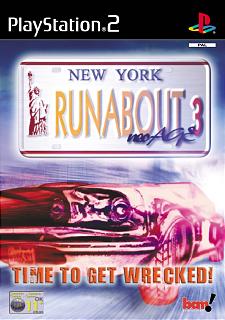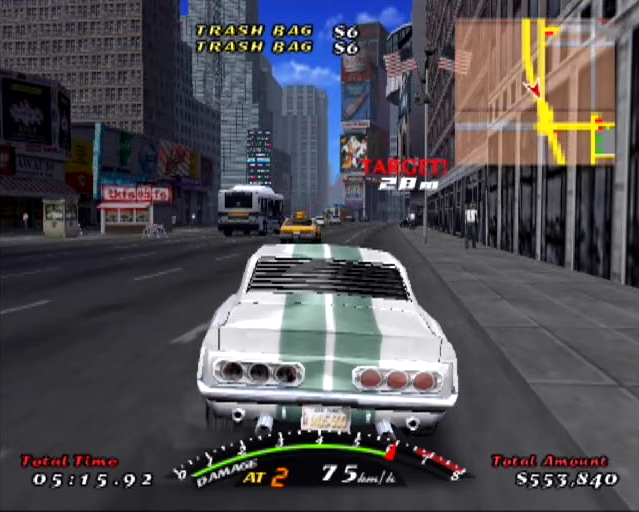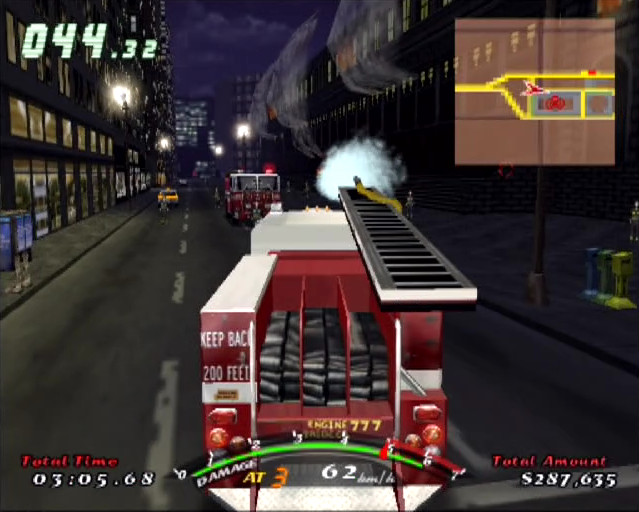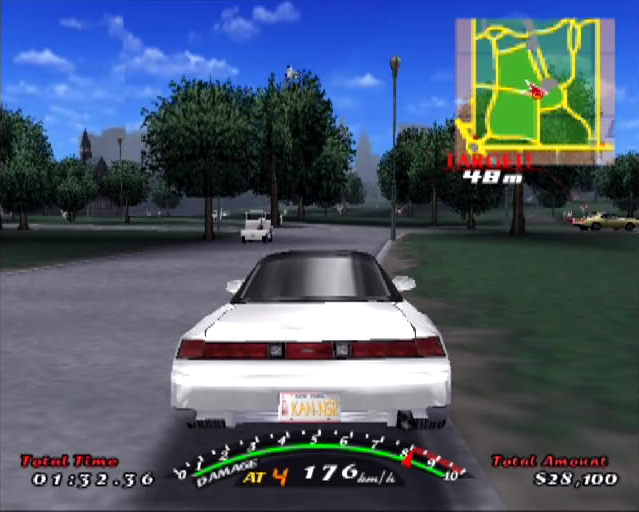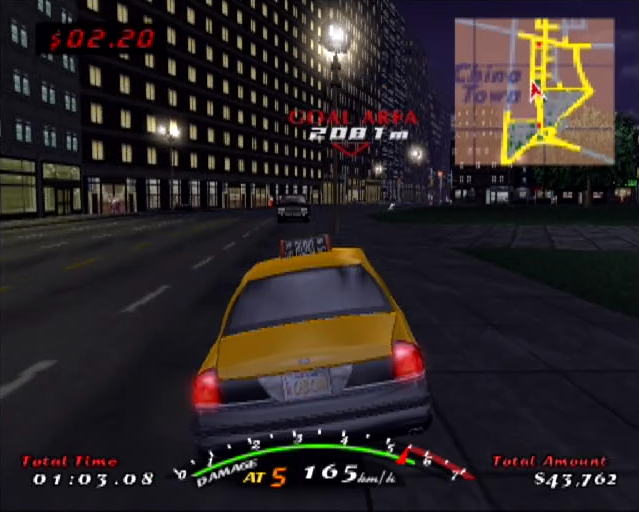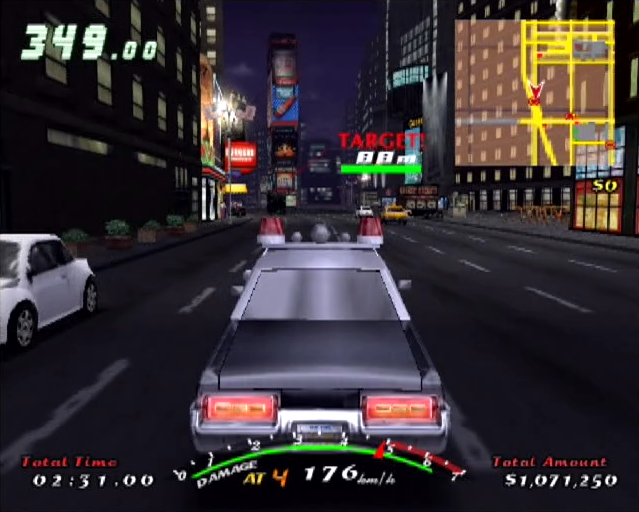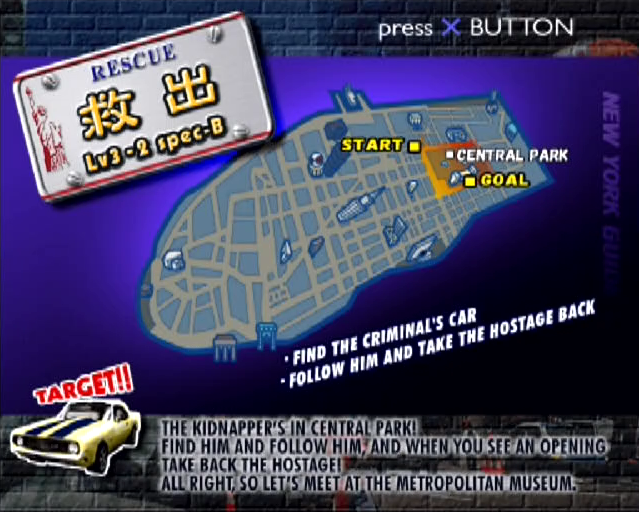RUNABOUT 3: NEO AGE (PS2)
Runabout 3 would bring to a close a sequence of four plucky driving games that largely mirrored one another’s strengths and deficiencies. The series’ heart was in the right place. By that, I mean its focus was always geared towards gameplay first and foremost, with smart asset management ensuring a surprising amount of replay value and good, honest, silly fun. Sadly, Neo Age wasn’t able to shake the technical foibles that dogged its predecessors. If anything, they were as pronounced as ever.
Its premise remains an entertaining one. A game to test your traffic-dodging abilities and all-round city driving skills, Neo Age trades the US west coast setting of Dreamcast instalment Super Runabout for the east coast and New York. As before, the unique selling point centres around the destructibility of the environments. More or less everything that isn’t the road, the sky or the framework of a building can be destroyed for points.
Runabout 3 lets you smash your way around New York in a zany array of vehicles
Missions aim to test the player’s driving acumen via a number of timed challenges. It’s action movie shtick that adds to the fun: racing to the scene of a fire, tailing a diplomat's wife, rescuing hostages, retrieving stolen money and so on. Each mission typically offers three variants to test different facets of your driving ability. Some task you with causing mass amounts of damage, whilst others demand that you reach your objective without so much as a scratch. Simplistic as these variations sound, they add quite a bit to the levels, as you’ll need to approach them from different angles.
The PlayStation 2 offered the series a considerable boost both in terms of processor power and memory, lending Runabout 3 the ideal opportunity to leave some of the more noticeable technical issues of the PlayStation instalments behind. You wouldn’t know this from how poorly it runs, however. Even taking into account a modest development budget, Neo Age can only be viewed as a disappointment.
Whilst the mission design is a little more adventurous than those featured in Super Runabout, what’s most immediately noticeable is the regression the game has taken in the technical stakes. Slowdown absolutely cripples the action, often reducing it to less than half-speed. The acrobatic crashes, which would otherwise have proven a highlight, are as often-as-not irritating for the incredibly sluggish and protracted manner in which they unfold. Not ideal when you’re up against the clock and all the more galling when your car lands awkwardly on its side or roof, leading to several more seconds passing before the car is belatedly reset.
The PlayStation 2 offered the series a considerable boost both in terms of processor power and memory, lending Runabout 3 the ideal opportunity to leave some of the more noticeable technical issues of the PlayStation instalments behind. You wouldn’t know this from how poorly it runs, however. Even taking into account a modest development budget, Neo Age can only be viewed as a disappointment.
Whilst the mission design is a little more adventurous than those featured in Super Runabout, what’s most immediately noticeable is the regression the game has taken in the technical stakes. Slowdown absolutely cripples the action, often reducing it to less than half-speed. The acrobatic crashes, which would otherwise have proven a highlight, are as often-as-not irritating for the incredibly sluggish and protracted manner in which they unfold. Not ideal when you’re up against the clock and all the more galling when your car lands awkwardly on its side or roof, leading to several more seconds passing before the car is belatedly reset.
These are frustrations that have troubled Runabout since its inception. On older hardware, it was understandable. However, by 2003, Grand Theft Auto: Vice City had already delivered a far larger, far better looking and busier city sandbox and managed to run it significantly more smoothly. Even chopping Runabout 3’s version of New York into smaller segments doesn’t save it from a myriad of technical restraints. It’s surprising to see it labour so much, with visuals that come nowhere close to showcasing the PlayStation 2’s potential. At times, it looks little better than an original PlayStation game. Granted, there’s plenty of destructible scenery, but some of the surrounds are so poorly defined, you’ll end up hitting walls or raised curbs that are indistinguishable from the roads.
One thing you can at least guarantee from a Runabout, however, is an absolutely bonkers selection of vehicles. You’ve the usual saloons, sports cars and taxis. These are your best bet for completing missions, as speed combined with some semblance of manoeuvrability is paramount here. Then you have some slightly more unusual choices, such as a motorbike, a bus and a fire engine. Finally, there’s the utterly ridiculous: a tank, a monster truck and (most unfathomably) a yacht. These are great fun for unleashing damage across the free play modes, but predictably useless for tackling missions as they occupy a huge amount of space and are horrifically slow. Vehicle balancing is really bad, with many proving so ponderous to drive that getting to the finish within the time limit, even with a relatively clean run, can be a gruelling and improbable endeavour.
One thing you can at least guarantee from a Runabout, however, is an absolutely bonkers selection of vehicles. You’ve the usual saloons, sports cars and taxis. These are your best bet for completing missions, as speed combined with some semblance of manoeuvrability is paramount here. Then you have some slightly more unusual choices, such as a motorbike, a bus and a fire engine. Finally, there’s the utterly ridiculous: a tank, a monster truck and (most unfathomably) a yacht. These are great fun for unleashing damage across the free play modes, but predictably useless for tackling missions as they occupy a huge amount of space and are horrifically slow. Vehicle balancing is really bad, with many proving so ponderous to drive that getting to the finish within the time limit, even with a relatively clean run, can be a gruelling and improbable endeavour.
Sadly, even splitting the city into chunks doesn't save Neo Age from a heap of technical issues
Like its predecessors, Neo Age manages to squeeze a surprising amount of play from a relatively limited array of levels. There are more than 300 kinds of scenery to smash, with unique or rare sorts encouraging a bit of exploration to find. These can be checked in the options menu, as can the 50 or so additional challenges relating to time, score and damage parameters that offer further incentive to replay story missions. They’re nothing out of the ordinary: new liveries and features for your vehicles, but they certainly give the levels some extra legs.
Before driving games became smothered by dour, contemporary licensed soundtracks (thanks, EA!), there was a certain novelty to be found in the more arcade-orientated, purpose-built efforts, such as Japanese band Surf Coaster’s accompaniment to Neo Age. Sprightly, springy rock adds tempo to the ludicrous action, offering apt, likeable and surprisingly consistent surf-rock selections across menus and missions. Sound effects and voicing are both minimal and forgettable.
Eighteen years later, the gaming scene is still arguably missing a full realisation of Runabout’s marvellous ideas. Indeed, had Neo Age featured stronger presentation, fewer technical hitches and less extravagant low-gravity crashes, it could have been a cracker. Sadly, it appeared archaic next to the likes of Burnout 2 which, through its success, would shift the emphasis away from the sandbox space and more towards car-to-car combat. To the end, Runabout did a sterling job of encouraging the player back for another dose of its high-jinks fun, but it was never able to conquer its technical demons. In 2003, Runabout 3 already felt like a relic from another era, with the PlayStation 2’s wealth of racing options ensuring this effervescent oddity would slip into obscurity, failing to make good on its considerable potential.
Before driving games became smothered by dour, contemporary licensed soundtracks (thanks, EA!), there was a certain novelty to be found in the more arcade-orientated, purpose-built efforts, such as Japanese band Surf Coaster’s accompaniment to Neo Age. Sprightly, springy rock adds tempo to the ludicrous action, offering apt, likeable and surprisingly consistent surf-rock selections across menus and missions. Sound effects and voicing are both minimal and forgettable.
Eighteen years later, the gaming scene is still arguably missing a full realisation of Runabout’s marvellous ideas. Indeed, had Neo Age featured stronger presentation, fewer technical hitches and less extravagant low-gravity crashes, it could have been a cracker. Sadly, it appeared archaic next to the likes of Burnout 2 which, through its success, would shift the emphasis away from the sandbox space and more towards car-to-car combat. To the end, Runabout did a sterling job of encouraging the player back for another dose of its high-jinks fun, but it was never able to conquer its technical demons. In 2003, Runabout 3 already felt like a relic from another era, with the PlayStation 2’s wealth of racing options ensuring this effervescent oddity would slip into obscurity, failing to make good on its considerable potential.
|
|
VERDICT
"Fun but deeply flawed... a relic from another era, with the PlayStation 2’s wealth of superior racing options ensuring this effervescent oddity would slip into obscurity." OVERALL: 4/10 |
